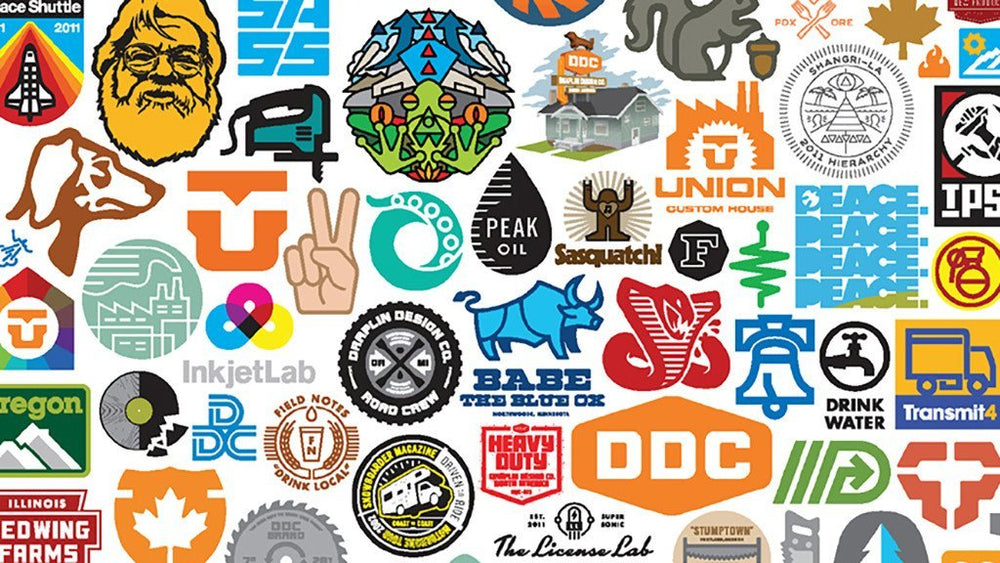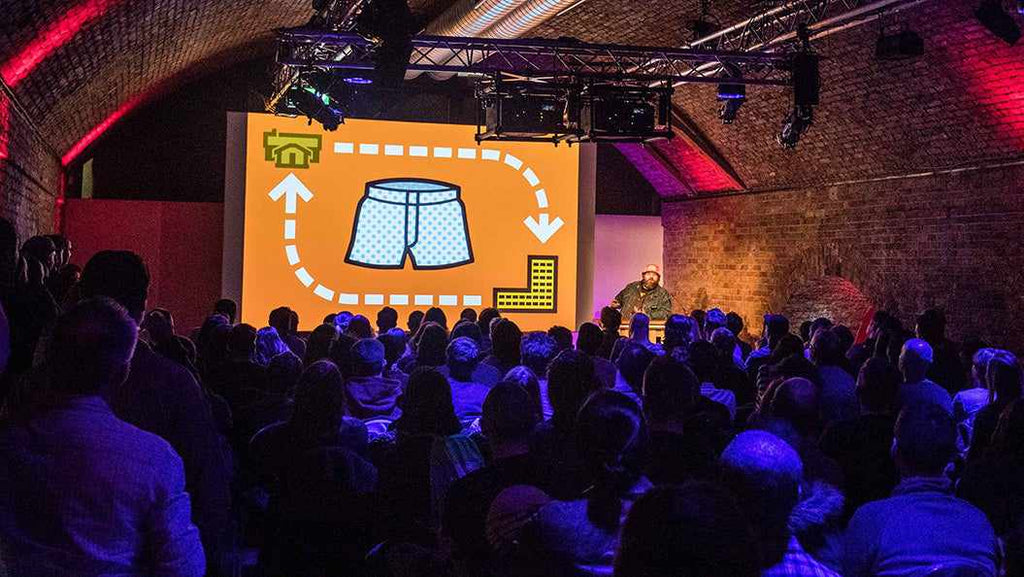
He might live just down the road from RetroSupply, but we caught up with legendary Portland-based designer Aaron Draplin in London, one particularly chilly evening back in late November. Visiting the UK for 24 hours only, he was headlining Adobe’s November Creative Meet Up in the capital’s trendy Bike Shed venue, casually adding a quick London leg to his hectic DDC Book Pretty Much Everything Tour world tour.
If you didn’t already know, Aaron has a new book out. Billed a ‘mid-career survey’ of his work by publisher Abrams (“That’s scary!”), Pretty Much Everything charts Aaron’s journey through design by way of inspiring case studies, insightful how-tos and candid discussions about the state of the industry.
What you might not know, though, is how much effort Aaron put into the publication. From planning to the design and pre-production – navigating the nightmares, tears and triumphs – Aaron put his all into the project.

Aaron didn't always wear pants while designing his book, Pretty Much Everything
“It was a weird summer because I gave myself entirely to it,” he told the audience at Adobe’s Creative Meet Up. “I was there all day. When I drove there sometimes I wouldn’t put my trousers on.”
During the event’s break, Aaron took five from his book signing – all the more generous, given the queues were backed up out the door – to talk to us about logo design, clients and beating imposter syndrome. We didn’t have long before he was whisked away to be miked up by the good people at Adobe, but true to form Aaron delivered some solid advice…
What are the biggest changes in what you’re being asked for by clients today, versus five years ago?

Images: Aaron Draplin’s Space Shuttle Poster Kit
AD: Can I build a website? And I can’t. So I have to hire in or recommend good people. It’s more just the whole package. It’s not just one little piece of design, it’s: can you build this, this, this and this? And the idea that we can deliver a client something that looks good on Twitter, Instagram and all the tiny little spaces, all the way up the food chain until it’s on the back of someone’s sweatshirt or on the side of their van.
That’s nothing new: that’s what Paul Rand did. Or Saul Bass. It’s nothing revolutionary. Really they’re asking you for simplification, which is kinda funny because I’m taking things that they thought needed to be complex and refining them down. People say it’s ground-breaking, but it’s not. I’m just clearing out the bullshit.
In your opinion, what makes a good logo?

Image: logos created by Draplin Design Company, courtesy Adobe Create Magazine
AD: Scalability, readability, and basic functional qualities to make it look good at the size of a pea or a softball, and then all the way up to where it works on large, large things. That’s the world we’re in now. Ninety-nine times out of a hundred, now, you’re gonna see that logo on your phone, in a little tiny space.
But scroll through your Twitter and you’ll see big corporations, or friends, or other people who just don’t have it together. It’s insane – you can’t even see the logo. You can’t read it. You have to make your designs work at all sizes.
Really, it’s usability across all platforms. That’s all clients ever ask for. So then you go look at the ones that are the good case studies. It’s scary to me how many big companies don’t understand.
You’re a super successful designer. What would you say to creatives who suffer from imposter syndrome?

Image: Philadelphia Freedom, Everything Ohio and Always Arizona posters
AD: There are a lot of ways to make any which one thing. Our job as designers is to make what’s appropriate for the problem and the client. There’s an idea that people come to me and I make things that look like ‘Aaron Draplin’ – but that’s weird, because there are a lot of things that I make that don’t look like ‘me’. I don’t celebrate them because it’s not appropriate for the client. But I did the job. It was appropriate for them.
Let’s just say it was my big buddy, and he’s big and he’s loud, and I design for that. And if it’s someone tiny and small and quiet, you design for that. The colors are different; the typeface is different.
I’ve heard about this impostor shit – that’s because of likes and clicks and people making certain things cool. But you know what? You’ve got to find your own way, and it’s going to be weird. I had to find my own way, and I failed a bunch of times too, so that shit’s gonna happen. I would say just loosen up, know what you know, dig what you dig and start making it.
What advice would you give to someone struggling to trust their own instincts?

Image: Aaron talking at Adobe’s London Creative Meet-Up
AD: I have a lot of kids come after me, but I didn’t invent thick lines or logos. I looked at Saul Bass. Am I an imposter of him? I hope so. I’ll never get there – it’s Saul Bass. But you look at those things and it’s basic principles of graphic design. That’s not a style: that’s something that’s meant to work in 2016 and 1966, and 50 years before that. I know it’s tricky because kids are trying to get known, but don’t worry about that shit. You may never get a like or a click, or whatever, but if you enjoy what you do, that’s pretty cool.
So just go and do it?

Image: Pretty Much Everything up to October 15th poster by Aaron Draplin
AD: Yeah. I mean, it’s almost too easy to say: ‘Just go and make something. It’s all going to be ok.’ No it’s not – how do you pay your bills? ‘I pay my bills working 9-5 gigs.’ Alright. So what? Go home and make whatever you want at 5.01. It could be your hobby. That’s ok. That’s what it was for me. And then I started to trick people and they started to like things they saw – they didn’t know I did it for a couple of records that I traded somebody.
You can manifest a life in this. That big poster I did that’s Pretty Much Everything up until October 2015 or something – that’s me making work that I want to do for my time on Earth. If someone likes some of it, they hire me for it, and the cycle keeps going. If they don’t, it’s ok. I still made it.
Your book has been positioned by Abrams as a “mid-career survey”. What was the single, biggest lesson you learned while designing it?

AD: That the nerdy planning I put into the thing was a great instinct. Mainly, I did it because I was scared. I didn’t want to screw up! I really thought through how I’d separate the sections, dig up the old material, sort it and prep it for production – right down to the file naming convention.
And in the end, that took a ton of pressure off the project. I didn’t have to sweat the idea that something that big would get out of control, with files in disarray, and this spider web of changes and versions. We adhered to a simple system and were able to knock the thing out in about four months!
Huge thanks to Aaron for his time. You can grab a copy of Pretty Much Everything right here.

